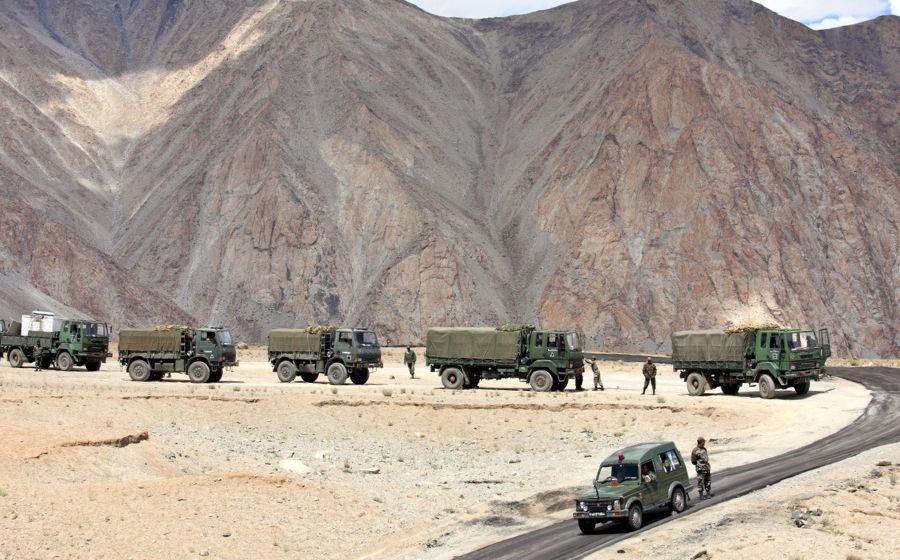
India, China vow to not escalate tension at LAC; no decision on friction points

Following a 14-hour meeting between military commanders of both sides on Monday (September 21), India and China have agreed that neither will send more troops to the frontline while refraining from unilaterally changing the situation on the ground and avoiding taking actions that may complicate matters, in a bid to thaw tension at the Line of Actual Control (LAC) in eastern Ladakh.
There, however, has been no agreement on “disengagement” at key friction points. A joint press statement released after the conclusion of talks only mentioned that they will “refrain from unilaterally changing the situation in the ground and avoid taking actions that may complicate the situation.” No clarification was given whether it indicated the current situation or the status quo that existed before the Chinese transgressions last year.
The sixth round of the Lieutenant-General-level talks held in Moldo, the Chinese side of the LAC, took place after Minister of Foreign Affairs S Jaishankar and his Chinese counterpart Wang Yi agreed to de-escalate tensions at the frontier during a meeting in Moscow.
In the statement, it was mentioned that the two sides also agreed to take practical measures to properly solve problems on the ground, and jointly safeguard peace and tranquillity in the border areas.
They also resolved to hold the 7th round of military commander talks as soon as possible. The announcement of a slew of decisions was made in identical statements released by the Indian and Chinese army in Delhi and Beijing simultaneously.
“The two sides had candid and in-depth exchange of views on stabilising the situation along the Line of Actual Control (LAC) in the India-China border areas,” said the statement released by the Indian Army. “They agreed to earnestly implement the important consensus reached by the leaders of the two countries, strengthen communication on the ground, avoid misunderstandings and misjudgments, stop sending more troops to the frontline, refrain from unilaterally changing the situation on the ground, and avoid taking any actions that may complicate the situation,” it said.
It is for the first time that the armies of the two countries have announced specific measures to ease tensions in eastern Ladakh after the face-off erupted in the Himalayan region in early May. Since then, they have rushed thousands of troops and heavy weaponry to almost all the sensitive areas along the LAC.
Chinese President Xi Jinping, meanwhile, said China will continue to narrow the differences and resolve disputes with others through negotiations, in comments that came against the backdrop of the Ladakh standoff. Addressing the general debate of the 75th session of the United Nations General Assembly, he said, “We will continue to narrow differences and resolve disputes with others through dialogue and negotiation.” “We will never seek hegemony, expansion, or sphere of influence. We have no intention to fight either a Cold War or a hot war with any country,” Xi said in a pre-recorded video message to the UN meeting.
The situation in Ladakh escalated manifold after 20 Indian soldiers were killed in violent clashes in Galwan Valley on June 15. The Chinese side too suffered casualties, but it is yet to divulge the details. The situation further deteriorated following at least three attempts by the soldiers of the Chinese People’s Liberation Army(PLA) to “intimidate” Indian troops along the northern and southern bank of Pangong lake area in the last three weeks where even shots were fired in the air for the first time at the LAC in 45 years.
As the tensions escalated further, the foreign ministers of the two countries held talks on the sidelines of a Shanghai Cooperation Organisation meet in Moscow on September 10 where they reached a five-point agreement to defuse the situation in eastern Ladakh. The agreement was the basis for the Monday talks which was also attended for the first time by a joint secretary of the Ministry of External Affairs(MEA). The agreement aimed at ending the tense standoff included measures like quick disengagement of troops, avoiding action that could escalate tensions, adherence to all agreements and protocols on border management and steps to restore peace along the LAC.
Monday’s talks began at around 9 am in Moldo on the Chinese side of the LAC across Indias Chushul sector in eastern Ladakh and ended at 11 PM. The two sides also mentioned the harsh winter in the Ladakh region beginning October when temperatures fall upto minus 25 degree Celsius and oxygen becomes scarce, the sources said. The Indian delegation was headed by Lt Gen Harinder Singh, the commander of the Leh-based 14 Corps of the Indian Army. It also comprised MEA Joint Secretary Naveen Srivastava, who has been engaged in diplomatic talks with China on the border row under the framework of the Working Mechanism for Consultation and Coordination (WMCC) on border affairs. The team also included Lt Gen PGK Menon, who is expected to succeed Singh as the commander of the 14 Corps next month.
(With inputs from agencies)

